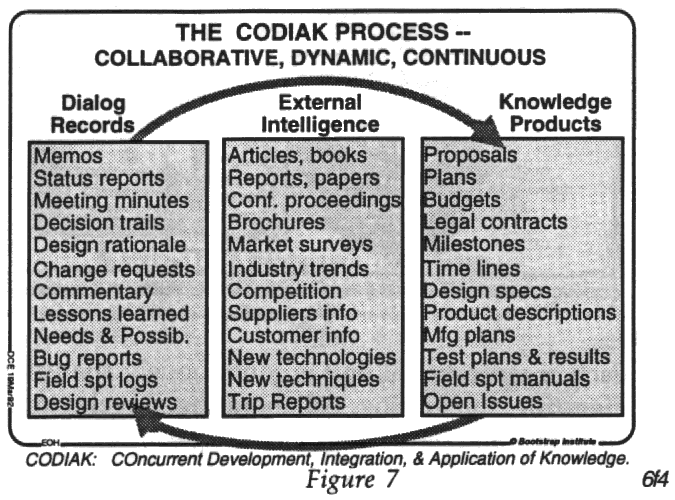No need to curb your enthusiasm ...
He asks if readers have a better explanation of the pattern he and Brynjolfsson observe: that since the 1990's a combination of the Web and IT spending on enterprise information systems has shifted the ability of businesses to recognize and deploy good ideas; that this has raised the pace and level of competition, making effective innovation more valuable, and more strongly differentiates winners and losers in competitive markets.
Borders, Spaces, and Places
For example - if you work for a law firm there's a reasonable - and legal - expectation that only the client and members of the firm have access to the collaborative space reserved for work with each specific client. But a member of the firm may be working with many different clients at the same time, and need to keep on top of many external engagements - and a host of internal engagements that are shared within the law firm but invisible to all clients.
This "hub and spoke" collaboration pattern is common for business. For example, if your company builds complex, customized products it's valuable to have separate collaboration spaces that connect each customer and your internal product development, sales and marketing team. Everyone on the inside has a bird's eye view across all customer specific work. Each customer sees a dedicated collaboration space for private working communication - and can also read or participate in spaces that you intentionally open to all your customers or the public Web.
Similarly, most businesses work with a network of external suppliers, resellers, technology or business partners and external service providers - including your law firm, accountants, PR firm and others. If you're interested in keeping touch with each of these external stakeholders and enabling your employees to have a birds eye view of what's happening across your entire business the hub and spoke pattern is also appropriate.
If your Enterprise 2.
Get a Bike Mr Kagermann!
.
. . the most important features for the managers who buy business software are still a system’s security and reliability, and whether the system helps a business comply with an ever-growing number of government regulations, says Kagermann. Systems bought by individuals or departments don’t have the company-wide perspective necessary to meet these goals - The Reason It's Called Management Software, WSJ. com
On Mr. Kagermann's last point - systems from small, agile suppliers are perfectly capable of meeting security, reliability and other business requirements based on a company wide perspective. And small and agile mammals discovered and evolved to reshape the world of ah.
A Cooperative Strategy for 21st Century Seapower Strategy | Video
Our citizens were involved in development of this strategy through a series of public forums known as the “Conversations with the Country.
Connections
Social networking promotes new and serendipitous connections among people (and in TeamPage 4.0 the content they create and comments they make within a business context). But the public Web - and bounded world of Enterprise 2.
Network scale search of blog content is one Web scaleable way to find out who's actively talking about or working on a topic that interests you. Once you find a relevant hit, you then have the opportunity to: 1) make a personal connection; 2) subscribe to a syndicated feed from that individual or group; 3) make your own blog post or wiki link to tell let others in your strongly connected group - and anyone else in the who can read your post - that you've found an interesting fact or connection. Blog / wiki connections make it possible to add situational context - including time based patterns of interest - to search, which is particularly valuable in the relatively small and link-poor enterprise.
Your post then becomes a new item which others can discover - or read if they subscribe to your personal or group blog / wiki - as a potentially valuable source. This weak signal amplification creates a spreading activation network that can quickly span the globe - and further extends and reinforces the network. It also reinforces the value of old fashioned and irreplaceable face to face connections by letting people keep in touch with their extended network without creating undue work for either the sender or receiver.
 The "social" part of software in the Enterprise 2.
The "social" part of software in the Enterprise 2.
Email isn't dead - It's only sleeping ...
Kevin Marks, a Google engineer and Technorati veteran, said in a talk about the company's OpenSocial project and Social Graph APIs that e-mail is a "strange legacy idea."
"E-mail has died away for a group of users. for the younger generation, they don't use e-mail," he said, talking about the young Web users who have started to abandon e-mail for Facebook messaging and mobile texting. "They see it as this noisy spam-filled thing that annoys them every day.
. . they see it as how you talk to the university, how you talk to the bank." Marks pointed to technologies like OpenID that promote the notion that online identities these days are defined by so much more than e-mail addresses--URLs and social-networking profiles, to name a few.
All enterprises have more knowledge in their employees as a group than any one person, even (especially?) the CEO. The worst case is where one person has a problem and another knows a solution, but neither knows the other – or that the other knows. Despite e-mail’s advantages for communication, it falls down as a close collaboration tool on complex projects: E-mail makes it hard to keep everything related to a particular project in one place; e-mailed attachments can lead to version-control nightmares; and it’s almost impossible to get the Cc:line right. If the Cc:line is too broad, it creates “occupational spam” – messages from co-workers that don’t matter to everyone addressed. If the Cc:line is too narrow, the activity becomes opaque to management or partners. -- Social Software: A New Generation of Tools by Clay Shirky, Release 1.0 Vol 21, No. 5, 20 May 2003 (.pdf)
Enterprise 2.0: Radical Change by Revolution or Mandate?

Ross Dawson's Enterprise 2.
Steve Hodgkinson, Ovum research director, sees Enterprise 2.
0 as a genuine opportunity for technology to act as a catalyst for changes in organisational culture. "Enterprise 2.
0 is emerging as the most practical way of sharing and managing knowledge in a range of contexts, from team collaboration to customer self-service forums. This leads to the ability to bring about cultural change with the personal power of informal networks such as wikis, blogs, profiles and forums." "The root of its culture change power, however, is its ability to unleash the personal power of informal networks," said Hodgkinson.
Key ideas within this new system include:
* The need for a flat organisation, rather than an organisational hierarchy
* Folksonomy rather than taxonomy
* User-driven technology rather than IT department control
* Short time-to-market cycles; to continue and increase flow
* Global teams of people, rather than locating the whole organisation in one building
* Emergent information systems, rather than dictated and structured information systems
* The opening of propriety standards
Beyond blogs and wikis
Traction starts from the blog end of the spectrum (actually it started from link Doug Engelbart's concept of a hypertext Journal) in that it records collaboration over time. But, the knowledge product of the collaboration - represented as a web of editable pages, office or CAD files - can be recorded and versioned in Traction along with the external intelligence and internal dialog about the creation and evolution of the product. The knowledge product can also reside in an external repository and become the subject of dialog using links from Traction. Both the dialog and knowledge product are typically created and edited as a purposeful group activity.
|

Traction Software's products are based on a model of group group editing in place combined with group collaboration over time that pre-dates blogs and Wiki's by over 40 years - see Blog50: Traction Roots - Doug Engelbart. For more information on Douglas Engelbart, the Godfather of effective collaboration, see Doug's Wikipedia page.
Use of Weblogs for Competitive Intelligence | First International Business, Technology CI Conference, Tokyo Oct 2005
Because the weblog is itself part of the public (or private) Web it can preserve a stable, addressable set of references, which can be linked to by any other Web source, or analyzed by any application that has permission to address that weblog’s content. This interoperability addresses Engelbart’s primary concern about proprietary and opaque representations (the norm prior to the Web) creating silos of information that would make universal linking and interchange difficult or impossible.
Like
Berners-Lee’s original concept of the Web, use of weblogs and wikis as
easily deployed and relatively stable authored indices to arbitrary Web
content is a pragmatic compromise. The Web’s naturally evolving
infrastructure provides complementary Web search, RSS/
Traction Roots - Doug Engelbart
Our Journal system was conceived by this author in about 1966. I wanted an underlying operational process, for use by individuals and groups, that would help bring order into the time stream of the Augmented Knowledge workers. The term "journal" emerged early in the conceptualization process for two reasons:
- I felt it important in many dynamic operations to keep a log (sometimes termed a "journal") that chronicles events by means of a series of unchangeable entries (for instance, to log significant events while evolving a Plan, shaping up a project, trouble-shooting a large operation. or monitoring on-going operations). These entries would be preserved in original form, serving as the grist for later integration into more organized treatments.
- I also wanted something that would serve essentially the same recorded-dialogue purpose as I perceived a professional journal (plus library) to do.
Tricycles vs. Training Wheels
I think it's better to build software with training wheels that are easy to recognize and remove, than to continue to build tricycles that no-one can grow out of. As Alan says, its a terrible mistake to assume that kids and and grownups will not spend the time to acquire new skills, so long as the payoff is great enough and mastery of the skill is itself a source of enjoyment. Mastery of Emacs can be just as enjoyable and rewarding as mastery of a video game.
Alan Kay: .
Doug Engelbart: Well, strangely enough, I feel the same. It's part of the thing of the easy to learn and natural to use thing that became sortof a god to follow and the marketplace is driving it and its successful and you could market on that basis, but some of the diagrams pictures that I didn't quite get to the other day was how do you ever migrate from a tricycle to a bicycle because a bicycle is very unnatural and very hard to learn compared to a tricycle, and yet in society it has superseded all the tricycles for people over five years old. So the whole idea of high-performance knowledge work is yet to come up and be in the domain. Its still the orientation of automating what you used to do instead of moving to a whole new domain in which you are going to obviously going to learn quite a few new skills. And so you make analogies of suppose you wanted to move up to the ski slopes and be mobile on skis. Well, just visiting them for an afternoon is not going to do it. So, I'd love to have photographs of skateboards and skis and windsurfing and all of that to show you what people can really if they have a new way supplied by technology to be mobile in a different environment. None of that could be done if people insisted that it was an easy-to-learn thing. .
Alan Kay: Looking back I think that one of the paradoxes is that we made a complete mistake when we were doing the interface at PARC because we assumed that the kids would need an easy interface because we were going to try and teach them to program and stuff like that, but in fact they are the ones who are willing to put hours into getting really expert at things - shooting baskets, learning to hit baseballs, learning to ride bikes, and now on video games. I have a four-year old nephew who is really incredible and he could use NLS [Engelbart's 1968 hypertext system] fantastically if it were available He would be flying through that stuff because his whole thing is to become part of the system he's interacting with and so if I had had that perspective I would have designed a completely different interface for the kids, one in which how you became expert was much more apparent than what I did. So I'm sorry for what I did.
 I18N ERROR: @tsiskin#footer_RSS_Feed
I18N ERROR: @tsiskin#footer_RSS_Feed